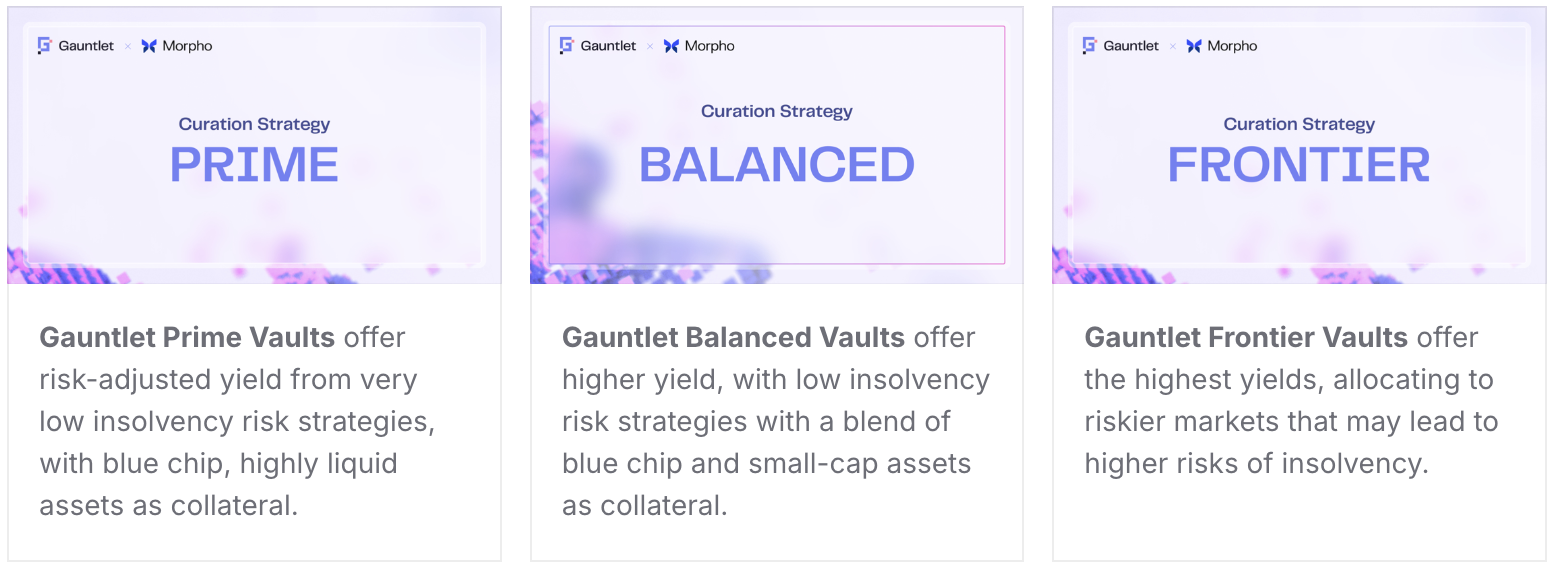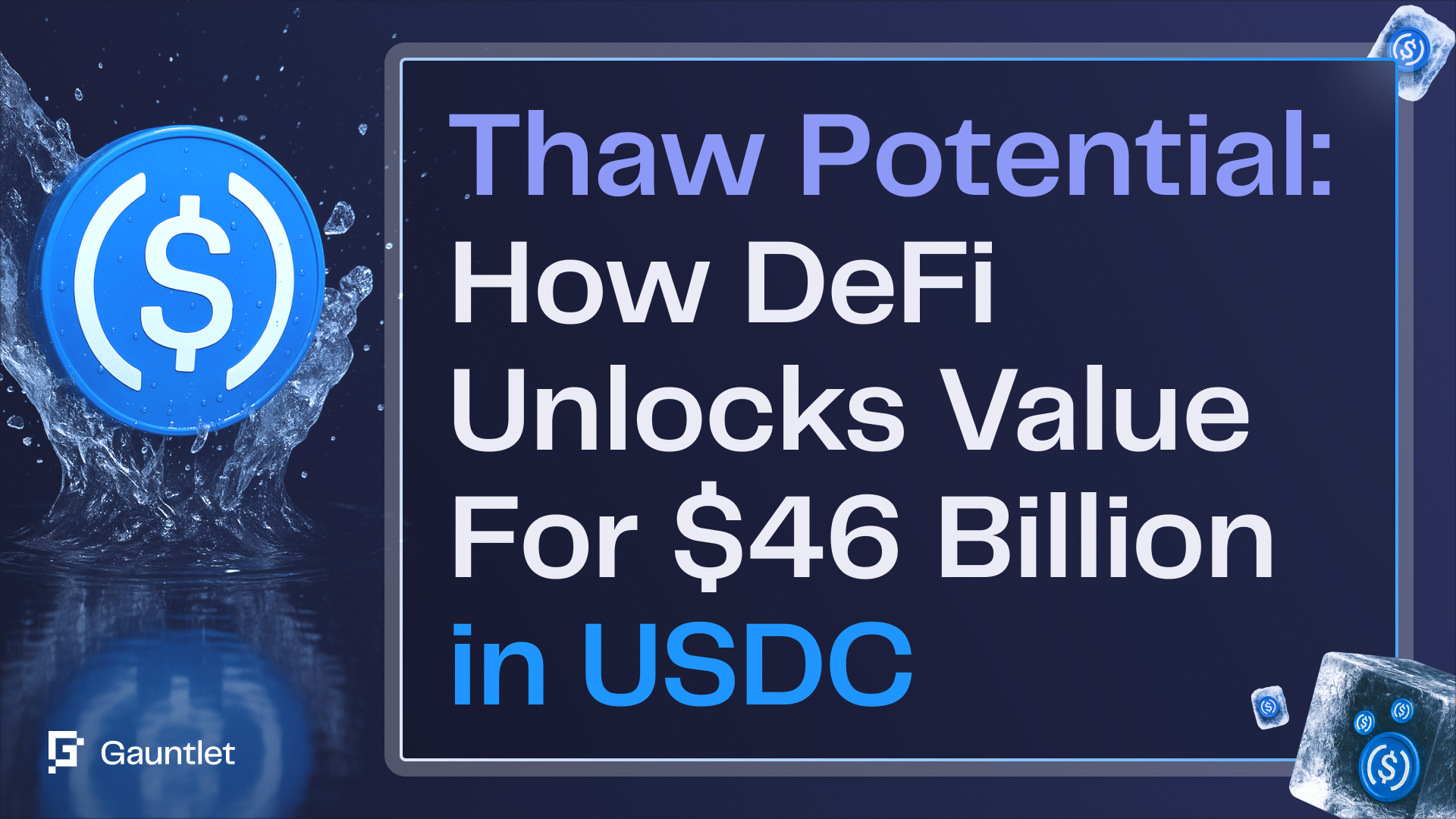From mid-October through early November, DeFi faced among its most significant solvency and liquidity shocks to date, including the largest liquidation event in its history and the subsequent Stream (xUSD) insolvency.
Throughout this period, Gauntlet Vaults incurred zero bad debt, maintained strong withdrawable liquidity, and preserved TVL, underscoring the strength of our curation framework, due diligence processes, and 24/7 liquidity monitoring. These outcomes highlight the importance of pairing yield opportunities in DeFi with robust risk management infrastructure. Notably, Gauntlet USDC Balanced on Morpho recorded a 35% increase in supply from November 2 - 12, 2025.

A primary criterion for evaluating a DeFi yield vault is resilience and solvency during moments of market stress. Likewise, traditional financial institutions view longevity under extreme volatility as a signal of trust.
With DeFi TVL soaring above $100B and more institutional dollars moving onchain with $30B+ in RWA TVL, analyses of stress events will only reinforce the transparency and trust that our industry has already built with traditional financial institutions.
Takeaways
Zero exposure, zero loss. Gauntlet vaults had no positions in Stream/xUSD or any other impacted assets, and our vaults suffered no losses.
Liquidity held under stress. Despite a new $100M borrower position in the cbBTC/USDC, USDC Prime maintained an average of approximately 53% withdrawable liquidity throughout the stress period and processed $42.8M (~40% TVL) in withdrawals within 48 hours without impairments.
Flight-to-quality validated. During the drawdown, Balanced (formerly “Core”)* TVL rose by +35%, while other curated vaults on Morpho fell by more than 60%, indicating a market preference for Gauntlet-curated vaults.
Dynamic rates absorbed the shock. Adaptive interest rate reflexivity reduced Balanced borrow by 27% and Frontier borrow by 72%, restoring full liquidity within hours instead of weeks.
Supply APY benefited from volatility. Between November 4 and 9, suppliers earned an annualized 13.3% APY in USDC Balanced (vs. 8.1% three-month average) and 15.0% in Frontier (vs. 9.3% three-month average).
Risk management infrastructure validated. Our vault-level controls operated as expected, with liquidity, concentration, and real-time telemetry all operating smoothly during the stress event period.
Gauntlet vault performance breakdown
Our lending vaults on Morpho are categorized into three tiers: Prime, Balanced, and Frontier, which target different levels of risk within our robust curation framework. You can read more about our vaults on our VaultBook.

*Gauntlet Balanced vaults were formerly Core vaults. Although the naming convention has been updated across Gauntlet materials, these vaults are still referred to as “Core” on the Morpho user interface.
Gauntlet USDC Prime on Ethereum Mainnet
The Gauntlet USDC Prime Morpho vault deployed on Ethereum Mainnet sustained strong liquidity throughout the stress period with $0 in bad debt. It averaged ~$79M in available liquidity with an average of 53% of supply available for immediate withdrawal, demonstrating resilience under volatile conditions.
During the period of extreme stress and volatility (~November 4), our Prime vault processed $42.8M (~40% TVL) in withdrawals within 48 hours without impairments or gating funds. TVL remained consistently above $130M.

Gauntlet USDC Balanced and Frontier on Ethereum Mainnet
Balanced and Frontier USDC Morpho vaults on Mainnet target higher yields than Prime by allocating to markets that may have lower liquidity but nevertheless meet our robust due diligence standards.
Relative to our Prime vaults, these experienced a temporary tightening of liquidity across allocated markets during the stress period, as competitor vaults with exposure to Stream and other impacted protocols saw an uptick in withdrawals. The low liquidity period lasted approximately six hours on November 4. Suppliers who remained in the vault realized higher APYs during the period, and liquidity recovered to at least 30-40% quickly each time.
As competitor vaults impacted by Stream and others withdrew virtually all of their liquidity to service withdrawals, liquidity tightened across non-impacted markets to which Gauntlet Balanced and Frontier were allocated.
The lowest level of withdrawable liquidity in Balanced and Frontier occurred on November 4, following the initial shock from Stream’s announcement at 2:55 AM UTC. Liquidity remained depressed below 1% for approximately six hours on the 4th (and briefly on November 7) before rebounding and entering a recovery phase with average liquidity above 40% for Balanced and above 30% for Frontier.
As illustrated in the chart below, users were compensated for the temporary liquidity constraints through elevated APYs, without any exposure to insolvency risk stemming from the xUSD contagion.

Users who maintained their supply in these vaults between November 4 and November 9 realized an APY of 13.3% for USDC Balanced and 15.0% for Frontier throughout the liquidity stress period.
During the liquidity compression period, our Balanced and Frontier vaults processed $42.8M, or 40% of pre-stress period TVL, in the first two days. A key protection mechanism for Morpho suppliers is the reflexivity of borrow behavior to rate changes. While lending is an inherently illiquid activity, the nature of Morpho's adaptive IRM and the reflexive nature of the Morpho ecosystem meant the liquidity compression lasted hours, not weeks, and with no impact on loan principal.
TVL performance shows trust in Gauntlet Vaults
Our USDC vaults demonstrated resilience compared to peer vaults during the November 2 to November 12 period. Notably, USDC Balanced TVL increased by over 35% during that period. Frontier declined by 20%, while other vaults on Morpho experienced TVL drawdowns exceeding 60%.

The sustained growth and stability of USDC Balanced, in particular, underscore the market's perception of Gauntlet-curated vaults as a trusted and resilient yield source during periods of market stress, reflecting both robust liquidity management and strong supplier confidence.
In a month defined by historic liquidations and liquidity shocks, Gauntlet Vaults demonstrated the resilience and solvency that institutional capital increasingly demands from onchain products. Our approach delivered zero losses, sustained liquidity, and net inflows while the market faced severe stress.
These results demonstrate that rigorous due diligence, secure allocation infrastructure, 24/7 liquidity monitoring, and battle-tested risk management standards are effective defenses against market instability. As DeFi scales, this foundation will be critical to earning and maintaining institutional trust.
Nicholas Del Zingaro, Staff DeFi Analyst
Michalis Alifierakis, Senior Machine Learning Engineer
Disclaimer: Gauntlet Networks, Inc. is not registered as an investment adviser, investment company, or broker-dealer, or custodian under any jurisdiction. This summary is provided for discussion purposes only and is not intended to provide tax, legal, investment, or financial advice. Please consult with your own analysis and advisors when evaluating the suitability of this strategy for your digital asset objectives. Vault Disclaimer.
Blog
View the full presentation
Read the full paper









